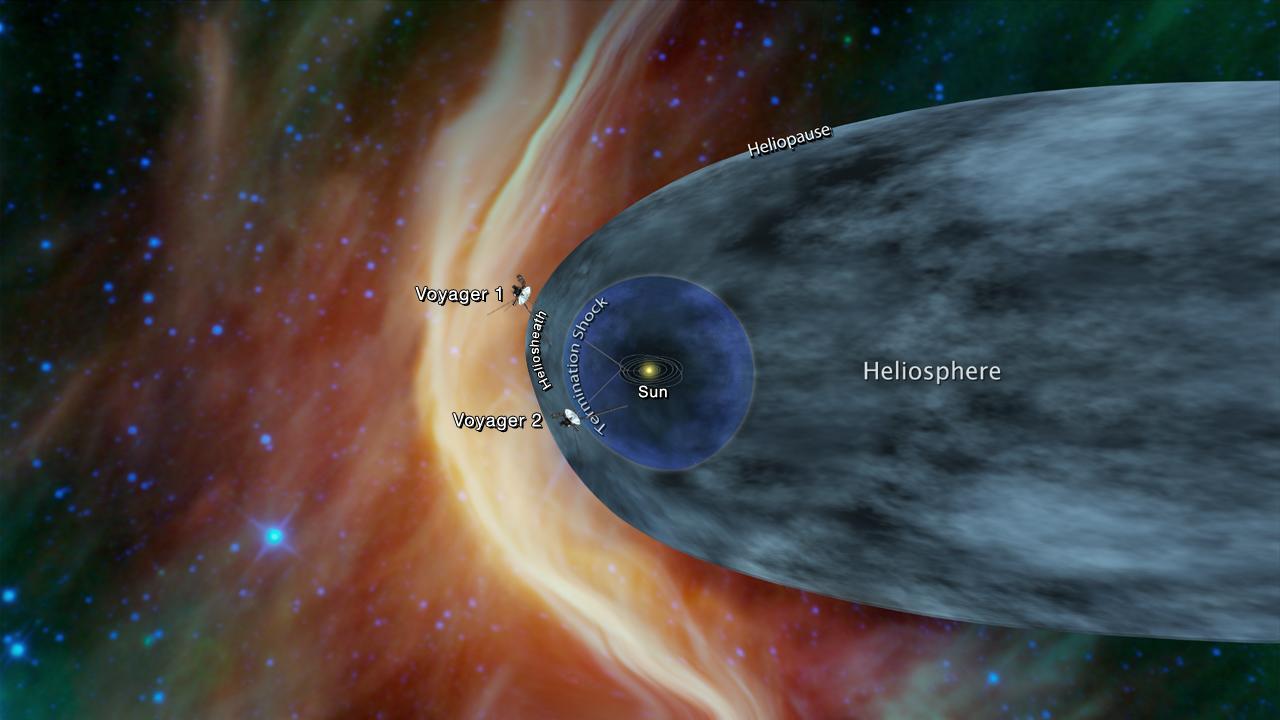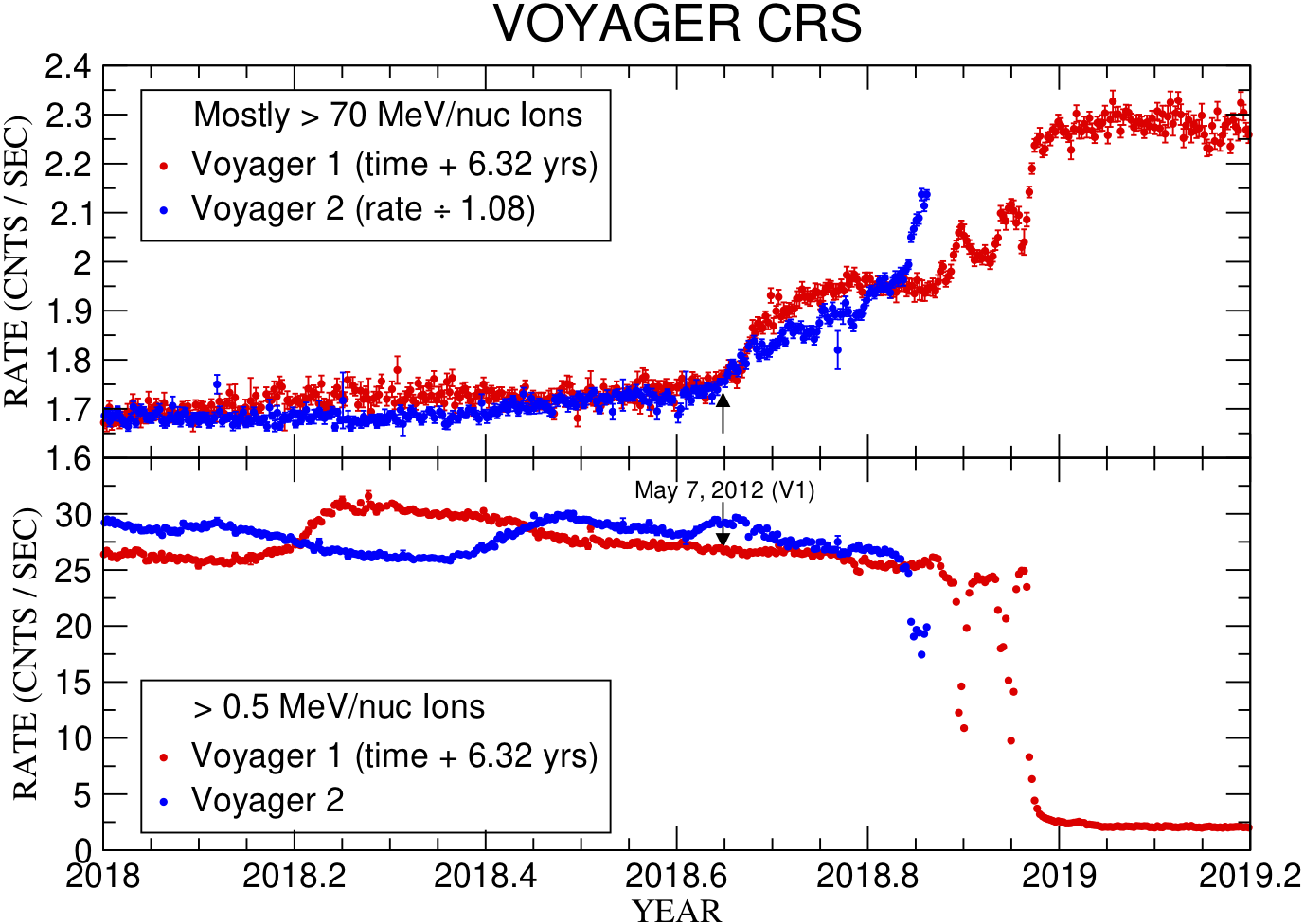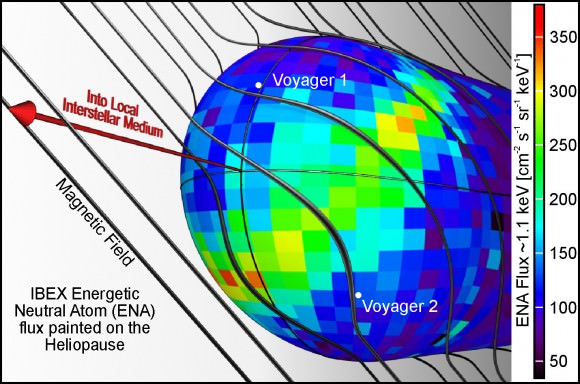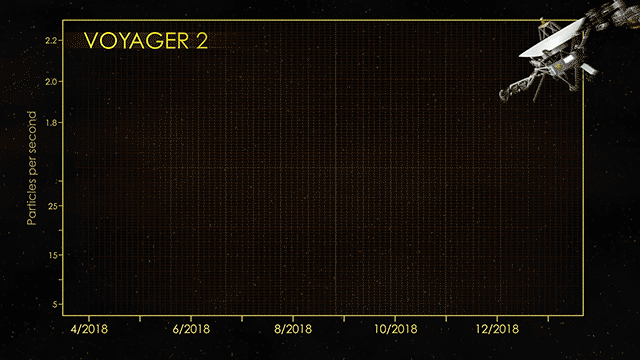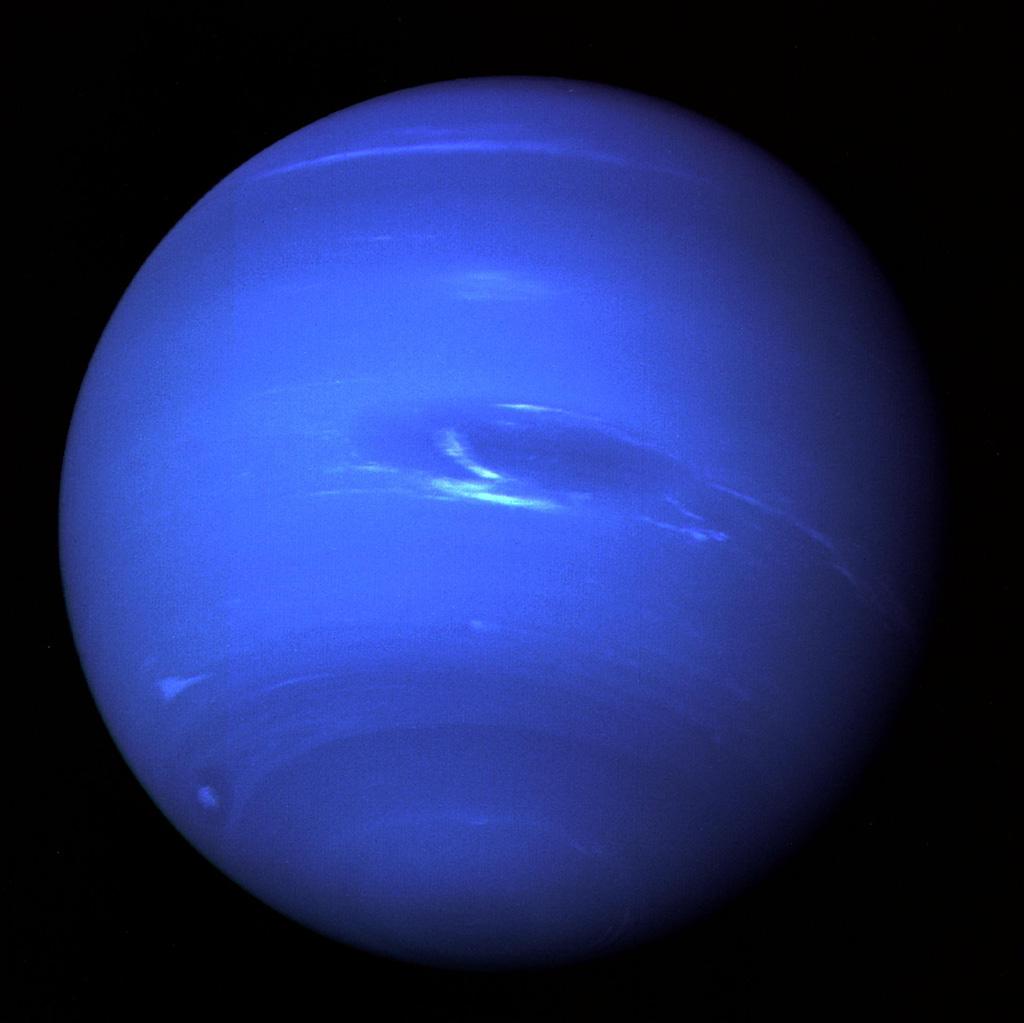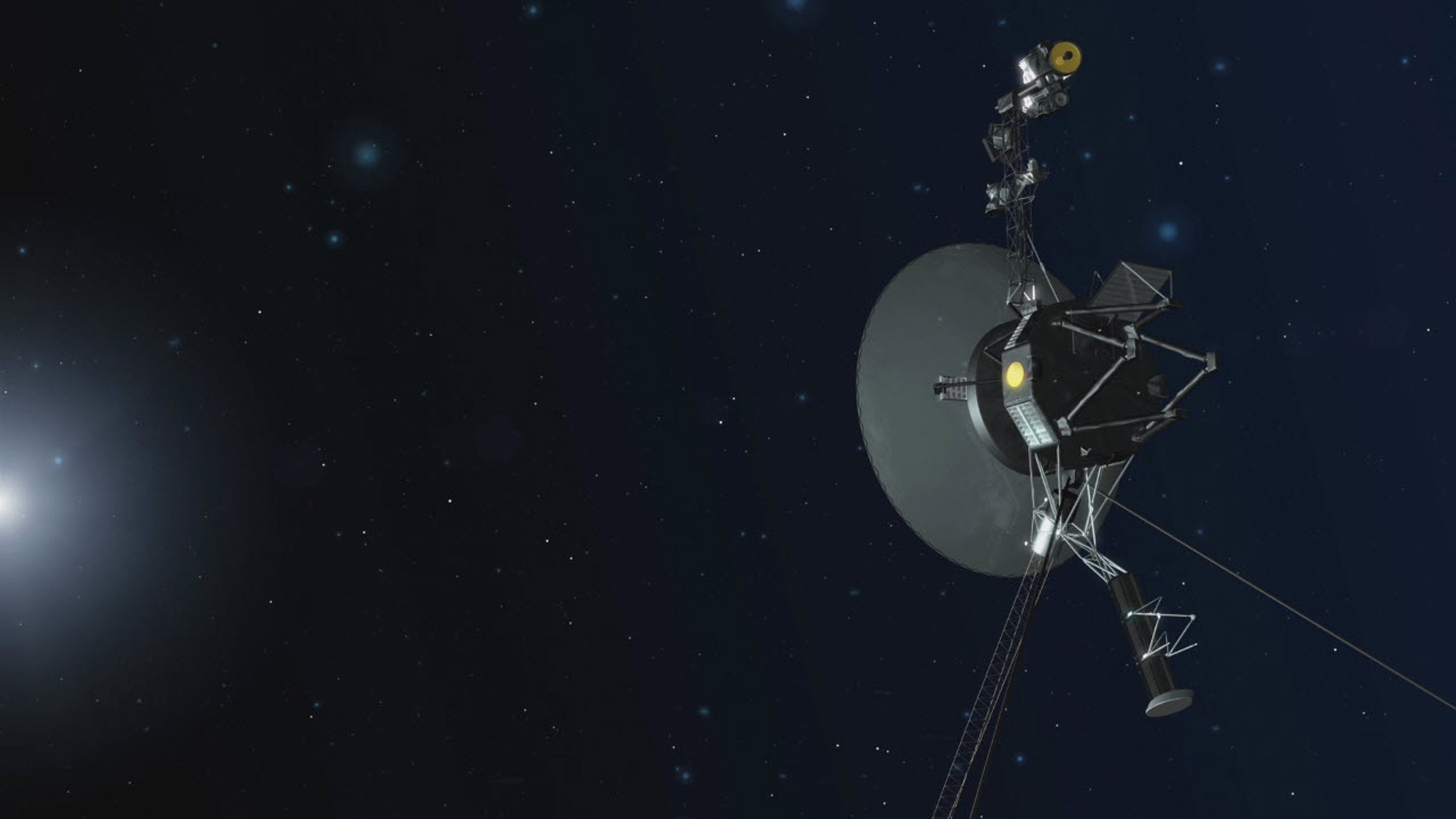Voyager I and II
Re: Voyager I and II
APOD Robot wrote: ( 2017 Sept 02 )
" Now humanity´s first ambassador to the Milky Way,
Voyager 1 is over 19 light-hours away, beyond the
heliosphere in interstellar space. Celebrate the
Voyagers´ 40 year journed toward the stars with
NASA on September 5. "
Congratulations !!
" Now humanity´s first ambassador to the Milky Way,
Voyager 1 is over 19 light-hours away, beyond the
heliosphere in interstellar space. Celebrate the
Voyagers´ 40 year journed toward the stars with
NASA on September 5. "
Congratulations !!
-
declareself
- Asternaut
- Posts: 5
- Joined: Mon Oct 09, 2017 12:07 am
Re: Voyager I and II
These missions caused us trillions of dollars
- neufer
- Vacationer at Tralfamadore
- Posts: 18805
- Joined: Mon Jan 21, 2008 1:57 pm
- Location: Alexandria, Virginia
Re: Voyager I and II
declareself wrote:
These missions caused us trillions of dollars
- Unnecessary wars cost trillions of dollars.
Spacecraft mission costs are more like a billion dollars.
https://www.reuters.com/article/us-iraq-war-anniversary/iraq-war-costs-u-s-more-than-2-trillion-study-idUSBRE92D0PG20130314 wrote:
NEW YORK (Reuters) - <<The U.S. war in Iraq has cost $1.7 trillion with an additional $490 billion in benefits owed to war veterans, expenses that could grow to more than $6 trillion over the next four decades counting interest, a study released on Thursday said. >>
https://voyager.jpl.nasa.gov/mission/did-you-know/ wrote:
<<The total cost of the Voyager mission from May 1972 through the Neptune encounter (including launch vehicles, radioactive power source (RTGs), and DSN tracking support) is 865 million dollars. At first, this may sound very expensive, but the fantastic returns are a bargain when we place the costs in the proper perspective. It is important to realize that:
A total of five trillion bits of scientific data had been returned to Earth by both Voyager spacecraft at the completion of the Neptune encounter. This represents enough bits to fill more than seven thousand music CDs.
- on a per-capita basis, this is only 8 cents per U.S. resident per year, or roughly half the cost of one candy bar each year since project inception. the entire cost of Voyager is a fraction of the daily interest on the U.S. national debt.
A total of 11,000 workyears was devoted to the Voyager project through the Neptune encounter. This is equivalent to one-third the amount of effort estimated to complete the great pyramid at Giza to King Cheops.
The sensitivity of our deep-space tracking antennas located around the world is truly amazing. The antennas must capture Voyager information from a signal so weak that the power striking the antenna is only 10-16 watts. A modern-day electronic digital watch operates at a power level 20 billion times greater than this feeble level.>>
Art Neuendorffer
Re: Voyager I and II
Suppose we eliminate the purchase of weaponsdeclareself wrote:These missions caused us trillions of dollars
Suppose we eliminate all the world´s army
Suppose we eliminate all kinds of wars
That would give an enormons quantity of
resources to invest in food and medicines
for millions of human beings. Indeed!
-
BDanielMayfield
- Don't bring me down
- Posts: 2524
- Joined: Thu Aug 02, 2012 11:24 am
- AKA: Bruce
- Location: East Idaho
Re: Voyager I and II
Beautiful thoughts saturno2.saturno2 wrote:Suppose we eliminate the purchase of weaponsdeclareself wrote:These missions caused us trillions of dollars
Suppose we eliminate all the world´s army
Suppose we eliminate all kinds of wars
That would give an enormons quantity of
resources to invest in food and medicines
for millions of human beings. Indeed!
I wonder if declareself’s incomplete comment was really a complaint about these missions’ costs. If so, it was over stated by a thousandfold or so, but he didn’t say “cost”, he said “caused”. Perhaps this is what he meant:
“These missions caused us trillions of dollars” of benefits in knowledge gained.
Bruce
Just as zero is not equal to infinity, everything coming from nothing is illogical.
-
BDanielMayfield
- Don't bring me down
- Posts: 2524
- Joined: Thu Aug 02, 2012 11:24 am
- AKA: Bruce
- Location: East Idaho
Re: Voyager I and II
I do declare, it be time fo declareself ta declare what the heck hisself wuz ameanin ta say y’all 
Just as zero is not equal to infinity, everything coming from nothing is illogical.
Voyager 1 Fires Up Thrusters After 37 Years
Voyager 1 Fires Up Thrusters After 37 Years
NASA | JPL-Caltech | Voyager | 2017 Dec 01
NASA | JPL-Caltech | Voyager | 2017 Dec 01
If you tried to start a car that's been sitting in a garage for decades, you might not expect the engine to respond. But a set of thrusters aboard the Voyager 1 spacecraft successfully fired up Wednesday after 37 years without use.
Voyager 1, NASA's farthest and fastest spacecraft, is the only human-made object in interstellar space, the environment between the stars. The spacecraft, which has been flying for 40 years, relies on small devices called thrusters to orient itself so it can communicate with Earth. These thrusters fire in tiny pulses, or "puffs," lasting mere milliseconds, to subtly rotate the spacecraft so that its antenna points at our planet. Now, the Voyager team is able to use a set of four backup thrusters, dormant since 1980. ...
Since 2014, engineers have noticed that the thrusters Voyager 1 has been using to orient the spacecraft, called "attitude control thrusters," have been degrading. Over time, the thrusters require more puffs to give off the same amount of energy. At 13 billion miles from Earth, there's no mechanic shop nearby to get a tune-up.
The Voyager team assembled a group of propulsion experts at NASA's Jet Propulsion Laboratory, Pasadena, California, to study the problem. Chris Jones, Robert Shotwell, Carl Guernsey and Todd Barber analyzed options and predicted how the spacecraft would respond in different scenarios. They agreed on an unusual solution: Try giving the job of orientation to a set of thrusters that had been asleep for 37 years. ...
Know the quiet place within your heart and touch the rainbow of possibility; be
alive to the gentle breeze of communication, and please stop being such a jerk. — Garrison Keillor
alive to the gentle breeze of communication, and please stop being such a jerk. — Garrison Keillor
- neufer
- Vacationer at Tralfamadore
- Posts: 18805
- Joined: Mon Jan 21, 2008 1:57 pm
- Location: Alexandria, Virginia
Re: Voyager 1 Fires Up Thrusters After 37 Years
Click to play embedded YouTube video.
bystander wrote:
Voyager 1 Fires Up Thrusters After 37 Years
NASA | JPL-Caltech | Voyager | 2017 Dec 01
If you tried to start a car that's been sitting in a garage for decades, you might not expect the engine to respond. But a set of thrusters aboard the Voyager 1 spacecraft successfully fired up Wednesday after 37 years without use.
Art Neuendorffer
Re: Voyager I and II
The Condor is an emblematic bird of my zone
( the zone of the Andes).
The Condor is a large bird and is caracterized
by flying high, very high.
The Condor passes is an original melody de Perú
which is recorded on the golden disk of
spacecraft Voyager.
Now, thanks to this melody, the Condor flies so
high, flies in the interstellar space...
( the zone of the Andes).
The Condor is a large bird and is caracterized
by flying high, very high.
The Condor passes is an original melody de Perú
which is recorded on the golden disk of
spacecraft Voyager.
Now, thanks to this melody, the Condor flies so
high, flies in the interstellar space...
Re: Voyager I and II
You mean this beautiful song, don't you, Saturno? I agree, it deserves to fly to the stars!saturno2 wrote: ↑Wed Jul 11, 2018 1:00 am The Condor is an emblematic bird of my zone
( the zone of the Andes).
The Condor is a large bird and is caracterized
by flying high, very high.
The Condor passes is an original melody de Perú
which is recorded on the golden disk of
spacecraft Voyager.
Now, thanks to this melody, the Condor flies so
high, flies in the interstellar space...
Click to play embedded YouTube video.
I have enjoyed your posts here!
Ann
Color Commentator
- neufer
- Vacationer at Tralfamadore
- Posts: 18805
- Joined: Mon Jan 21, 2008 1:57 pm
- Location: Alexandria, Virginia
Re: Voyager I and II
Ann wrote: ↑Wed Jul 11, 2018 6:03 amYou mean this beautiful [Simon & Garfunkel] song, don't you, Saturno?saturno2 wrote: ↑Wed Jul 11, 2018 1:00 am
The Condor is an emblematic bird of my zone
( the zone of the Andes).
The Condor is a large bird and is caracterized
by flying high, very high.
The Condor passes is an original melody de Perú
which is recorded on the golden disk of
spacecraft Voyager.
Now, thanks to this melody, the Condor flies so
high, flies in the interstellar space...
I agree, it deserves to fly to the stars!
https://en.wikipedia.org/wiki/El_C%C3%B3ndor_Pasa_(song) wrote:<<El Cóndor Pasa, Spanish for "The Condor Passes") is an orchestral musical piece from the zarzuela El Cóndor Pasa by the Peruvian composer Daniel Alomía Robles, written in 1913 and based on traditional Andean music, specifically folk music from Peru. In 2004, Peru declared this song as part of the national cultural heritage. This song is now considered the second national anthem of Peru.Click to play embedded YouTube video.Click to play embedded YouTube video.
Daniel Alomía Robles's "El Cóndor Pasa" was first performed publicly at the Teatro Mazzi in Lima in 1913. The song was originally a musical piece in the Peruvian zarzuela (musical play), El cóndor pasa. The piano arrangement of this play's most famous melody was legally registered on May 3, 1933 by The Edward B. Marks Music Corp. in the Library of Congress, under the number 9643. The zarzuela is written in prose and consists of one musical play and two acts.
In 1965, the American musician Paul Simon heard for the first time a version of the melody by the band Los Incas in a performance at the Théâtre de l'Est parisien in Paris in which both were participating. Simon became friendly with Los Incas band, later even touring with them and producing their first US-American album. He asked the band for permission to use the song in his production. The band's director and founding member Jorge Milchberg, who was collecting royalties for the song as co-author and arranger, responded erroneously that it was a traditional Peruvian composition. Milchberg told Simon he was registered as the arrangement's co-author and collected royalties.
In 1970, the Simon & Garfunkel duo covered the Los Incas version, adding some English lyrics which in turn added Paul Simon to the author credits under the song name "El Cóndor Pasa (If I Could)". The instrumental version by Los Incas was used as the base track. They included the song on the 1970 album Bridge Over Troubled Water. Simon & Garfunkel released their version as a single in the U.S., which reached #18 on the Billboard Pop Singles chart and #6 on the Easy Listening chart, in fall 1970. This cover achieved major international success and fame.
In late 1970, Daniel Alomía Robles' son Armando Robles Godoy, a Peruvian filmmaker, filed a successful copyright lawsuit against Paul Simon. The grounds for the lawsuit extended that the song had been composed by his father, who had copyrighted the song in the United States in 1933. Armando Robles Godoy said that he held no ill will towards Paul Simon for what he considered a "misunderstanding" and an "honest mistake". "It was an almost friendly court case because Paul Simon was very respectful of other cultures. It was not carelessness on his part," said Armando Robles Godoy. "He happened to hear the song in Paris from a vernacular group Los Incas. He liked it, he went to ask the band for permission and they gave him the wrong information. Jorge Milchberg told him it was a traditional folk song from the 18th century and not my father's composition. It was a court case without further complications.">>
Art Neuendorffer
Re: Voyager I and II
Thanks for correcting me, Art. Indeed, the song is not by Paul Simon.
Ann
Ann
Color Commentator
Re: Voyager I and II
Ann, thanks, thank you very much,
Neufer, thanks for your important explanation,
The melody the condor passes has 4.000 versions.
It has not an original letter, but it has 300
Letters, ( wikipedia)
Neufer, thanks for your important explanation,
The melody the condor passes has 4.000 versions.
It has not an original letter, but it has 300
Letters, ( wikipedia)
Voyager 2 Could Be Nearing Interstellar Space
Voyager 2 Could Be Nearing Interstellar Space
NASA | JPL-Caltech | Voyager 2 | 2018 Oct 05
NASA | JPL-Caltech | Voyager 2 | 2018 Oct 05
NASA's Voyager 2 probe, currently on a journey toward interstellar space, has detected an increase in cosmic rays that originate outside our solar system. Launched in 1977, Voyager 2 is a little less than 11 billion miles (about 17.7 billion kilometers) from Earth, or more than 118 times the distance from Earth to the Sun.
- This graphic shows the position of the Voyager 1 and Voyager 2 probes relative to the heliosphere, a protective bubble created by the Sun that extends well past the orbit of Pluto. Voyager 1 crossed the heliopause, or the edge of the heliosphere, in 2012. Voyager 2 is still in the heliosheath, or the outermost part of the heliosphere. (Credits: NASA/JPL-Caltech)
Since 2007 the probe has been traveling through the outermost layer of the heliosphere -- the vast bubble around the Sun and the planets dominated by solar material and magnetic fields. Voyager scientists have been watching for the spacecraft to reach the outer boundary of the heliosphere, known as the heliopause. Once Voyager 2 exits the heliosphere, it will become the second human-made object, after Voyager 1, to enter interstellar space.
Since late August, the Cosmic Ray Subsystem instrument on Voyager 2 has measured about a 5 percent increase in the rate of cosmic rays hitting the spacecraft compared to early August. The probe's Low-Energy Charged Particle instrument has detected a similar increase in higher-energy cosmic rays.
Cosmic rays are fast-moving particles that originate outside the solar system. Some of these cosmic rays are blocked by the heliosphere, so mission planners expect that Voyager 2 will measure an increase in the rate of cosmic rays as it approaches and crosses the boundary of the heliosphere.
In May 2012, Voyager 1 experienced an increase in the rate of cosmic rays similar to what Voyager 2 is now detecting. That was about three months before Voyager 1 crossed the heliopause and entered interstellar space. ...
Know the quiet place within your heart and touch the rainbow of possibility; be
alive to the gentle breeze of communication, and please stop being such a jerk. — Garrison Keillor
alive to the gentle breeze of communication, and please stop being such a jerk. — Garrison Keillor
Re: Voyager I and II
Voyager 2 is near ( perhaps ) of the interstellar space
Very, very interesting
Very, very interesting
Voyager 2 Enters Interstellar Space
Voyager 2 Enters Interstellar Space
NASA | JPL-Caltech | Voyager 2 | 2018 Dec 10
NASA | JPL-Caltech | Voyager 2 | 2018 Dec 10
For the second time in history, a human-made object has reached the space between the stars. NASA’s Voyager 2 probe now has exited the heliosphere – the protective bubble of particles and magnetic fields created by the Sun. ...Click to play embedded YouTube video.
Comparing data from different instruments aboard the trailblazing spacecraft, mission scientists determined the probe crossed the outer edge of the heliosphere on Nov. 5. This boundary, called the heliopause, is where the tenuous, hot solar wind meets the cold, dense interstellar medium. Its twin, Voyager 1, crossed this boundary in 2012, but Voyager 2 carries a working instrument that will provide first-of-its-kind observations of the nature of this gateway into interstellar space.
Voyager 2 now is slightly more than 11 billion miles (18 billion kilometers) from Earth. Mission operators still can communicate with Voyager 2 as it enters this new phase of its journey, but information – moving at the speed of light – takes about 16.5 hours to travel from the spacecraft to Earth. By comparison, light traveling from the Sun takes about eight minutes to reach Earth. ...
Know the quiet place within your heart and touch the rainbow of possibility; be
alive to the gentle breeze of communication, and please stop being such a jerk. — Garrison Keillor
alive to the gentle breeze of communication, and please stop being such a jerk. — Garrison Keillor
- neufer
- Vacationer at Tralfamadore
- Posts: 18805
- Joined: Mon Jan 21, 2008 1:57 pm
- Location: Alexandria, Virginia
Re: Voyager 2 Enters Interstellar Space
https://blogs.nasa.gov/sunspot/2018/11/14/excitement-increases-as-voyager-2-sees-a-decrease-in-heliospheric-particles/ wrote:
Excitement Increases as Voyager 2 sees a decrease in Heliospheric Particles
By Susannah Darling & Miles Hatfield
NASA Headquarters, November 14, 2018
<<While there was a drop in the heliospheric particles, at the same time the higher energy telescope observed increased counting rates. This graph displays both the higher energy counting rate data (top graph) together with the lower energy data (bottom graph):
[In September of 2013, NASA announced that Voyager 1 had crossed the heliopause as of August 25, 2012 at a distance of ~121 AU from the Sun during Solar MAX.] Voyager 1 data from 2012-2013 is shown in the red lines, with time shifted by 6.32 years. The Voyager 2 data from this year is shown in blue. As you can see, the High Energy Telescope of the CRS on Voyager 2 has been steadily increasing since October 2018, but the past few data points have shot up faster than expected [at a distance of ~119 AU from the Sun during Solar MIN]. This loss of heliospheric particles and gains in interstellar particles is expected when leaving the heliosphere, exciting scientists that Voyager 2 is close to crossing the heliopause.>>
Art Neuendorffer
CSIRO: We're All Ears as Voyager 2 Goes Interstellar
We're All Ears as Voyager 2 Goes Interstellar
Commonwealth Scientific and Industrial Research Organisation (CSIRO) | 2018 Dec 10
Commonwealth Scientific and Industrial Research Organisation (CSIRO) | 2018 Dec 10
Australia’s national science agency, CSIRO, is supporting NASA’s Voyager 2 spacecraft as it enters interstellar space – becoming only the second spacecraft, after its twin Voyager 1, to reach this milestone.
Voyager 2 is approximately 18 billion kilometres from Earth. Voyager mission scientists have been closely monitoring the spacecraft for signs that it has exited the ‘heliosphere,’ a protective bubble created by our Sun as we move through our galaxy.
NASA has today announced that on 5 November 2018, Voyager 2 crossed the outer edge of the heliosphere to reach the space between the stars.
On 8 November 2018, CSIRO’s Parkes radio telescope joined NASA’s Canberra Deep Space Communication Complex (CDSCC), part of NASA’s Deep Space Network, to receive unique and historic data from Voyager 2. This provides a clearer picture of the environment through which Voyager 2 is travelling. The Parkes telescope will continue to receive downlink data into early 2019.
Because of Voyager 2’s location and distance from Earth, CDSCC and the Parkes telescope are the only facilities in the world that are capable of having contact with the spacecraft. Voyager 2 isn’t able to record its data on board -- it transmits it directly from the instruments back to Earth -- making it essential to receive as much of this vital data as possible. ...
Know the quiet place within your heart and touch the rainbow of possibility; be
alive to the gentle breeze of communication, and please stop being such a jerk. — Garrison Keillor
alive to the gentle breeze of communication, and please stop being such a jerk. — Garrison Keillor
- neufer
- Vacationer at Tralfamadore
- Posts: 18805
- Joined: Mon Jan 21, 2008 1:57 pm
- Location: Alexandria, Virginia
Re: Voyager I and II
https://www.universetoday.com/140850/finally-voyager-2-is-now-in-interstellar-space/#more-140850 wrote:
<<At the end of 2018, the cosmic ray subsystem aboard NASA’s Voyager 2 spacecraft provided evidence that Voyager 2 had left the heliosphere. There were steep drops in the rate of heliospheric particles that hit the instrument’s radiation detector, and significant increases in the rate of cosmic rays.>>
Credit: NASA/JPL-Caltech/GSFC
Art Neuendorffer
-
BDanielMayfield
- Don't bring me down
- Posts: 2524
- Joined: Thu Aug 02, 2012 11:24 am
- AKA: Bruce
- Location: East Idaho
Re: Voyager I and II
"At the end of 2018, ... Credit: NASA"
NASA doesn't realize 2018 hasn't ended yet?
NASA doesn't realize 2018 hasn't ended yet?
Just as zero is not equal to infinity, everything coming from nothing is illogical.
Re: Voyager I and II
A pale blue dot is a photograph of the Earth taken
By the probe Voyager 1 from a distance of 6 billion km
On February 14 / 1990 ( Wikipedia )
The image shows the Earth as a speck or a
" pale blue dot " in middle of the sun's rays.
Carl Sagan wrote:
" Look at that point. That is here. That is our home.
That is us... Every saint or sinner in the history of
Our specie lived there, in a speck of dust suspended
In a ray of Sun.
The Earth is a small stage in the vast cosmic sand...
Our positions, our imaginary importance, the illusion
That we occupy a privileged position in the universe...
Is chalenged by that point of pale light...
... Maybe there is no better demostration of the
Madness of human concepts that this distant image
Of our tiny world. For me, it underlines our responsability
To treat each other better, and to preserve and to want
That PALE BLUE DOT, the only home, that we have
Always know. "
By the probe Voyager 1 from a distance of 6 billion km
On February 14 / 1990 ( Wikipedia )
The image shows the Earth as a speck or a
" pale blue dot " in middle of the sun's rays.
Carl Sagan wrote:
" Look at that point. That is here. That is our home.
That is us... Every saint or sinner in the history of
Our specie lived there, in a speck of dust suspended
In a ray of Sun.
The Earth is a small stage in the vast cosmic sand...
Our positions, our imaginary importance, the illusion
That we occupy a privileged position in the universe...
Is chalenged by that point of pale light...
... Maybe there is no better demostration of the
Madness of human concepts that this distant image
Of our tiny world. For me, it underlines our responsability
To treat each other better, and to preserve and to want
That PALE BLUE DOT, the only home, that we have
Always know. "
JPL: A New Plan for Keeping NASA's Oldest Explorers Going
A New Plan for Keeping NASA's Oldest Explorers Going
NASA | JPL-Caltech | Voyager | 2019 Jul 08
NASA | JPL-Caltech | Voyager | 2019 Jul 08
With careful planning and dashes of creativity, engineers have been able to keep NASA's Voyager 1 and 2 spacecraft flying for nearly 42 years - longer than any other spacecraft in history. To ensure that these vintage robots continue to return the best science data possible from the frontiers of space, mission engineers are implementing a new plan to manage them. And that involves making difficult choices, particularly about instruments and thrusters.
One key issue is that both Voyagers, launched in 1977, have less and less power available over time to run their science instruments and the heaters that keep them warm in the coldness of deep space. Engineers have had to decide what parts get power and what parts have to be turned off on both spacecraft. But those decisions must be made sooner for Voyager 2 than Voyager 1 because Voyager 2 has one more science instrument collecting data - and drawing power - than its sibling.
After extensive discussions with the science team, mission managers recently turned off a heater for the cosmic ray subsystem instrument (CRS) on Voyager 2 as part of the new power management plan. The cosmic ray instrument played a crucial role last November in determining that Voyager 2 had exited the heliosphere, the protective bubble created by a constant outflow (or wind) of ionized particles from the Sun. Ever since, the two Voyagers have been sending back details of how our heliosphere interacts with the wind flowing in interstellar space, the space between stars.
Not only are Voyager mission findings providing humanity with observations of truly uncharted territory, but they help us understand the very nature of energy and radiation in space - key information for protecting NASA's missions and astronauts even when closer to home.
Mission team members can now preliminarily confirm that Voyager 2's cosmic ray instrument is still returning data, despite dropping to a chilly minus 74 degrees Fahrenheit (minus 59 degrees Celsius). This is lower than the temperatures at which CRS was tested more than 42 years ago (down to minus 49 degrees Fahrenheit, or minus 45 degrees Celsius). Another Voyager instrument also continued to function for years after it dropped below temperatures at which it was tested. ...
Voyager 2 continues to return data from five instruments as it travels through interstellar space. In addition to the cosmic ray instrument, which detects fast-moving particles that can originate from the Sun or from sources outside our solar system, the spacecraft is operating two instruments dedicated to studying plasma (a gas in which atoms have been ionized and electrons float freely) and a magnetometer (which measures magnetic fields) for understanding the sparse clouds of material in interstellar space.
Taking data from a range of directions, the low-energy charged particle instrument is particularly useful for studying the probe's transition away from our heliosphere. Because CRS can look only in certain fixed directions, the Voyager science team decided to turn off CRS's heater first.
Voyager 1, which crossed into interstellar space in August 2012, continues to collect data from its cosmic ray instrument as well, plus from one plasma instrument, the magnetometer and the low-energy charged particle instrument. ...
Know the quiet place within your heart and touch the rainbow of possibility; be
alive to the gentle breeze of communication, and please stop being such a jerk. — Garrison Keillor
alive to the gentle breeze of communication, and please stop being such a jerk. — Garrison Keillor
30 Years Ago: Voyager 2's Historic Neptune Flyby
30 Years Ago: Voyager 2's Historic Neptune Flyby
NASA | JPL-Caltech | Voyager 2 | 2019 Aug 22
NASA | JPL-Caltech | Voyager 2 | 2019 Aug 22
Thirty years ago, on Aug. 25, 1989, NASA's Voyager 2 spacecraft made a close flyby of Neptune, giving humanity its first close-up of our solar system's eighth planet. Marking the end of the Voyager mission's Grand Tour of the solar system's four giant planets - Jupiter, Saturn, Uranus and Neptune - that first was also a last: No other spacecraft has visited Neptune since.
- This picture of Neptune was taken by Voyager 2 less than five days before the probe's closest approach of the planet on Aug. 25, 1989. The picture shows the 'Great Dark Spot' - a storm in Neptune's atmosphere - and the bright, light-blue smudge of clouds that accompanies the storm. Credit: NASA/JPL-Caltech
"The Voyager planetary program really was an opportunity to show the public what science is all about," said Ed Stone, Voyager's project scientist since 1975. "Every day we learned something new."
Wrapped in teal- and cobalt-colored bands of clouds, the planet that Voyager 2 revealed looked like a blue-hued sibling to Jupiter and Saturn, the blue indicating the presence of methane. A massive, slate-colored storm was dubbed the "Great Dark Spot," similar to Jupiter's Great Red Spot. Six new moons and four rings were discovered.
During the encounter, the engineering team carefully changed the probe's direction and speed so that it could do a close flyby of the planet's largest moon, Triton. The flyby showed evidence of geologically young surfaces and active geysers spewing material skyward. This indicated that Triton was not simply a solid ball of ice, even though it had the lowest surface temperature of any natural body observed by Voyager: minus 391 degrees Fahrenheit (minus 235 degrees Celsius).
The conclusion of the Neptune flyby marked the beginning of the Voyager Interstellar Mission, which continues today, 42 years after launch. Voyager 2 and its twin, Voyager 1 (which had also flown by Jupiter and Saturn), continue to send back dispatches from the outer reaches of our solar system. At the time of the Neptune encounter, Voyager 2 was about 2.9 billion miles (4.7 billion kilometers) from Earth; today it is 11 billion miles (18 billion kilometers) from us. The faster-moving Voyager 1 is 13 billion miles (21 billion kilometers) from Earth. ...
Know the quiet place within your heart and touch the rainbow of possibility; be
alive to the gentle breeze of communication, and please stop being such a jerk. — Garrison Keillor
alive to the gentle breeze of communication, and please stop being such a jerk. — Garrison Keillor
Voyager 2 Illuminates Boundary of Interstellar Space
Voyager 2 Illuminates Boundary of Interstellar Space
NASA | JPL-Caltech | Voyager 2 | 2019 Nov 04
Cosmic Ray Measurements from Voyager 2
as It Crossed into Interstellar Space ~ Edward C. Stone et al
Heliopause and Interstellar Medium ~ John D. Richardson et al
by Voyager 2 at and Near the Heliopause ~ L. F. Burlaga et al
Voyager 2 at the Heliopause and Beyond ~ Stamatios M. Krimigis et al
the Voyager 1 and 2 Plasma Wave Instruments ~ D. A. Gurnett, W. S. Kurth
NASA | JPL-Caltech | Voyager 2 | 2019 Nov 04
One year ago, on Nov. 5, 2018, NASA's Voyager 2 became only the second spacecraft in history to leave the heliosphere — the protective bubble of particles and magnetic fields created by our Sun. At a distance of about 11 billion miles (18 billion kilometers) from Earth — well beyond the orbit of Pluto — Voyager 2 had entered interstellar space, or the region between stars. Today, five new research papers in the journal Nature Astronomy describe what scientists observed during and since Voyager 2's historic crossing.
- This artist's concept shows one of NASA's Voyager spacecraft entering interstellar space, or the space between stars. This region is dominated by plasma ejected by the death of giant stars millions of years ago. Hotter, sparser plasma fills the environment inside our solar bubble. Credits: NASA/JPL-Caltech
Each paper details the findings from one of Voyager 2's five operating science instruments: a magnetic field sensor, two instruments to detect energetic particles in different energy ranges and two instruments for studying plasma (a gas composed of charged particles). Taken together, the findings help paint a picture of this cosmic shoreline, where the environment created by our Sun ends and the vast ocean of interstellar space begins.
The Sun's heliosphere is like a ship sailing through interstellar space. Both the heliosphere and interstellar space are filled with plasma, a gas that has had some of its atoms stripped of their electrons. The plasma inside the heliosphere is hot and sparse, while the plasma in interstellar space is colder and denser. The space between stars also contains cosmic rays, or particles accelerated by exploding stars. Voyager 1 discovered that the heliosphere protects Earth and the other planets from more than 70% of that radiation.
When Voyager 2 exited the heliosphere last year, scientists announced that its two energetic particle detectors noticed dramatic changes: The rate of heliospheric particles detected by the instruments plummeted, while the rate of cosmic rays (which typically have higher energies than the heliospheric particles) increased dramatically and remained high. The changes confirmed that the probe had entered a new region of space. ...
Cosmic Ray Measurements from Voyager 2
as It Crossed into Interstellar Space ~ Edward C. Stone et al
- Nature Astronomy (online 04 Nov 2019) DOI: 10.1038/s41550-019-0928-3
Heliopause and Interstellar Medium ~ John D. Richardson et al
- Nature Astronomy (online 04 Nov 2019) DOI: 10.1038/s41550-019-0929-2
by Voyager 2 at and Near the Heliopause ~ L. F. Burlaga et al
- Nature Astronomy (online 04 Nov 2019) DOI: 10.1038/s41550-019-0920-y
Voyager 2 at the Heliopause and Beyond ~ Stamatios M. Krimigis et al
- Nature Astronomy (online 04 Nov 2019) DOI: 10.1038/s41550-019-0927-4
the Voyager 1 and 2 Plasma Wave Instruments ~ D. A. Gurnett, W. S. Kurth
- Nature Astronomy (online 04 Nov 2019) DOI: 10.1038/s41550-019-0918-5
Know the quiet place within your heart and touch the rainbow of possibility; be
alive to the gentle breeze of communication, and please stop being such a jerk. — Garrison Keillor
alive to the gentle breeze of communication, and please stop being such a jerk. — Garrison Keillor
- orin stepanek
- Plutopian
- Posts: 8200
- Joined: Wed Jul 27, 2005 3:41 pm
- Location: Nebraska
Re: Voyager I and II
Voyager I and II; the little engines that could!  Wow; took 42 years to travel 2/3 of a light day! So; who would want to travel to the nearest exoplanet at 4 light years away?
Wow; took 42 years to travel 2/3 of a light day! So; who would want to travel to the nearest exoplanet at 4 light years away? 
How are these little space probes going to fare in interstellar space with all the extra radiation?
How are these little space probes going to fare in interstellar space with all the extra radiation?
Orin
Smile today; tomorrow's another day!
Smile today; tomorrow's another day!


